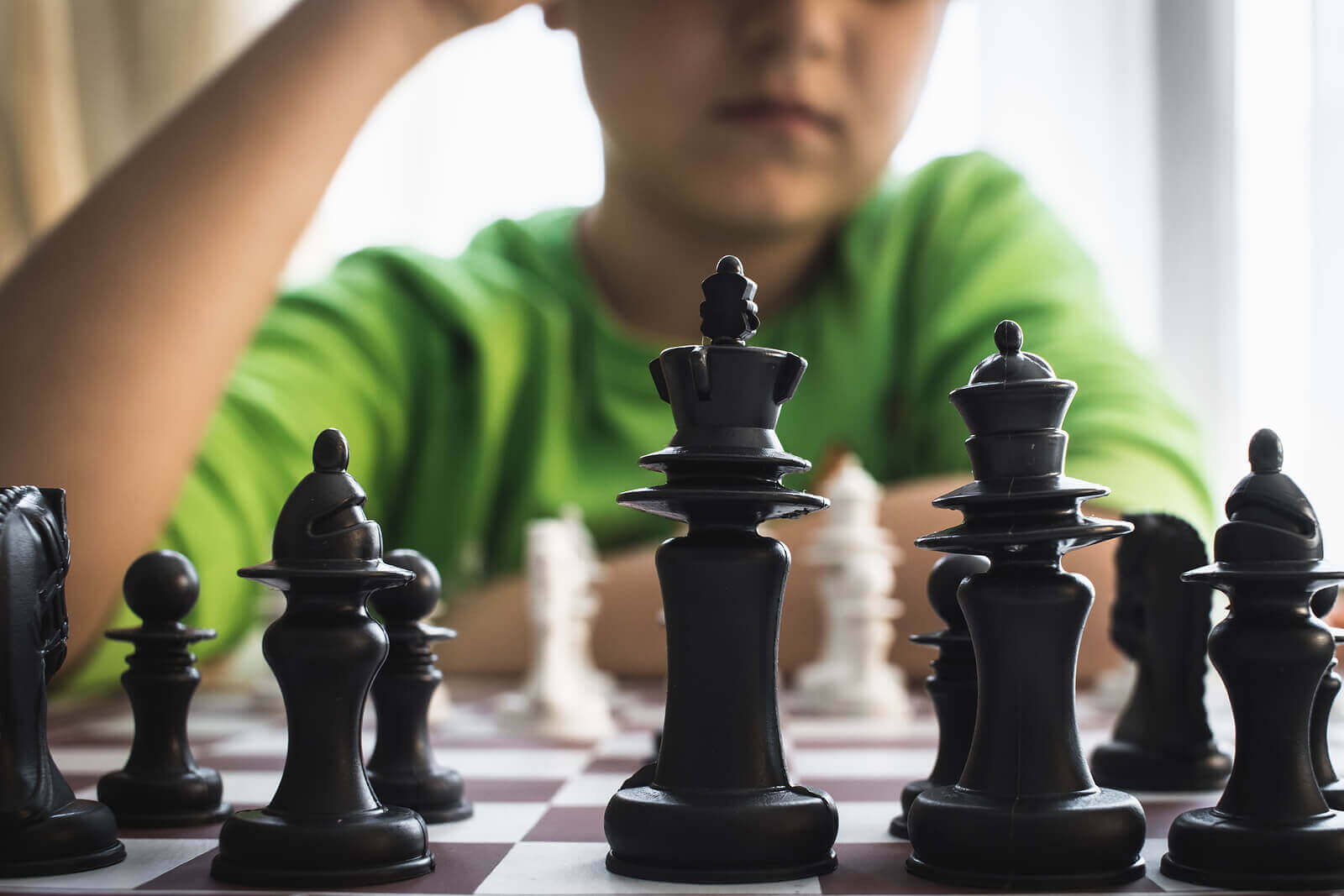Alternative Thinking, the Key to Mental Flexibility

Do you know what alternative thinking is? It’s the key (and the basis) of mental flexibility, as it helps us to grow as people and to seek different perspectives regarding the same situation.
Likewise, it takes us out of rigid thinking and allows us to have a more creative mind in all areas of life. For all of these reasons, it’s so important to instill it in children from a young age.
Next, we’ll tell you everything you need to know about alternative thinking and how to encourage it in your children.
Alternative thinking

When we think, we shape ideas through executive brain function. In this way, we make a mental representation of the reality that surrounds us and give rise to new ideas or different points of view for the same situation.
Alternative thinking is that tool that helps us manage our thoughts from a different perspective. In general, this is usually quite positive and encourages us to seek solutions to the problems that arise and to see life in a more optimistic way.
This mental skill focuses on actively searching for solutions, like brainstorming. Also, creativity increases in order to think of the strategies that best adapt to our circumstances and our possibilities.
The imagination focuses on the positive aspects of things and those possibilities for improvement and progress.
In short, alternative thinking is what makes us react and feel in a certain way when faced with a certain situation.
Difficulties in developing flexible thinking in children
When children have difficulty with alternative thinking or are inflexible, they run the risk of seeing things only one way.
Rigid thinking doesn’t allow them to adapt well to changes and leads them to get stuck in repetitive and pessimistic thoughts. They have a hard time finding solutions to problems because they can’t see beyond the negative aspects of things. In fact, they lack strategies to project or solve problems successfully.
All of this can negatively affect learning and life performance in general, both at home and at school.
Faced with a problem, they’re paralyzed and do nothing. And in the vast majority of cases, they wait for others to resolve their conflicts because they don’t feel capable of doing it on their own. This generates enormous frustration and anger towards themselves and towards the environment.
Some characteristics of mental rigidity in children are the following:
- They don’t usually accept other people’s ideas.
- They talk about the same thing over and over again.
- They get frustrated whenever things go wrong, but they repeat the same mistakes.
- They don’t like changes or new challenges because they produce nervousness.
- They get angry when others don’t follow the rules.
Causes of mental flexibility problems
Typically, children with attention deficit hyperactivity disorder (ADHD) often have difficulty developing alternative thinking. However, this isn’t an exclusive feature of this condition.
It’s very common that when parents are authoritarian or rigid-thinking, their children are, too.
A slower than expected processing speed can also manifest itself through a limitation of alternative thinking. This is because there’s less capacity to adapt to change and few strategies to seek creative solutions.
Helping Children Enhance Alternative Thinking

To promote alternative thinking in children, it’s good to keep in mind some of the following tips:
- Encourage brainstorming to find solutions to a specific problem.
- Divide a complicated task into several simpler ones.
- Give possible options to solve a problem and thus reduce anxiety. Likewise, encourage children to choose the alternative that best suits that circumstance.
- Working on this kind of thinking with board or card games. By seeing the play options of the other players, it’ll be easier for them to imitate them.
- Analyze and debate about the teachings of stories and movies, as well as the variables to resolve the different conflicts in the stories.
All of these are very useful for working on children’s alternative thinking as a basis for mental flexibility. But in general, any game, activity, or experience that involves creativity is also welcome to get your little one’s mind to develop in this regard.
Do you know what alternative thinking is? It’s the key (and the basis) of mental flexibility, as it helps us to grow as people and to seek different perspectives regarding the same situation.
Likewise, it takes us out of rigid thinking and allows us to have a more creative mind in all areas of life. For all of these reasons, it’s so important to instill it in children from a young age.
Next, we’ll tell you everything you need to know about alternative thinking and how to encourage it in your children.
Alternative thinking

When we think, we shape ideas through executive brain function. In this way, we make a mental representation of the reality that surrounds us and give rise to new ideas or different points of view for the same situation.
Alternative thinking is that tool that helps us manage our thoughts from a different perspective. In general, this is usually quite positive and encourages us to seek solutions to the problems that arise and to see life in a more optimistic way.
This mental skill focuses on actively searching for solutions, like brainstorming. Also, creativity increases in order to think of the strategies that best adapt to our circumstances and our possibilities.
The imagination focuses on the positive aspects of things and those possibilities for improvement and progress.
In short, alternative thinking is what makes us react and feel in a certain way when faced with a certain situation.
Difficulties in developing flexible thinking in children
When children have difficulty with alternative thinking or are inflexible, they run the risk of seeing things only one way.
Rigid thinking doesn’t allow them to adapt well to changes and leads them to get stuck in repetitive and pessimistic thoughts. They have a hard time finding solutions to problems because they can’t see beyond the negative aspects of things. In fact, they lack strategies to project or solve problems successfully.
All of this can negatively affect learning and life performance in general, both at home and at school.
Faced with a problem, they’re paralyzed and do nothing. And in the vast majority of cases, they wait for others to resolve their conflicts because they don’t feel capable of doing it on their own. This generates enormous frustration and anger towards themselves and towards the environment.
Some characteristics of mental rigidity in children are the following:
- They don’t usually accept other people’s ideas.
- They talk about the same thing over and over again.
- They get frustrated whenever things go wrong, but they repeat the same mistakes.
- They don’t like changes or new challenges because they produce nervousness.
- They get angry when others don’t follow the rules.
Causes of mental flexibility problems
Typically, children with attention deficit hyperactivity disorder (ADHD) often have difficulty developing alternative thinking. However, this isn’t an exclusive feature of this condition.
It’s very common that when parents are authoritarian or rigid-thinking, their children are, too.
A slower than expected processing speed can also manifest itself through a limitation of alternative thinking. This is because there’s less capacity to adapt to change and few strategies to seek creative solutions.
Helping Children Enhance Alternative Thinking

To promote alternative thinking in children, it’s good to keep in mind some of the following tips:
- Encourage brainstorming to find solutions to a specific problem.
- Divide a complicated task into several simpler ones.
- Give possible options to solve a problem and thus reduce anxiety. Likewise, encourage children to choose the alternative that best suits that circumstance.
- Working on this kind of thinking with board or card games. By seeing the play options of the other players, it’ll be easier for them to imitate them.
- Analyze and debate about the teachings of stories and movies, as well as the variables to resolve the different conflicts in the stories.
All of these are very useful for working on children’s alternative thinking as a basis for mental flexibility. But in general, any game, activity, or experience that involves creativity is also welcome to get your little one’s mind to develop in this regard.
All cited sources were thoroughly reviewed by our team to ensure their quality, reliability, currency, and validity. The bibliography of this article was considered reliable and of academic or scientific accuracy.
- Bausela Herreras, E. (2014). Funciones ejecutivas: nociones del desarrollo desde una perspectiva neuropsicológica. Revista mexicana de investigación educativa, vol.11 no.1. Disponible en: https://scielo.isciii.es/scielo.php?script=sci_arttext&pid=S1578-908X2014000100003
- Mayo Clinic. El TDAH en niños. [Internet] Disponible en: https://www.mayoclinic.org/es-es/diseases-conditions/adhd/symptoms-causes/syc-20350889#:~:text=El%20trastorno%20por%20d%C3%A9ficit%20de,atenci%C3%B3n%2C%20hiperactividad%20y%20comportamiento%20impulsivo.
This text is provided for informational purposes only and does not replace consultation with a professional. If in doubt, consult your specialist.








